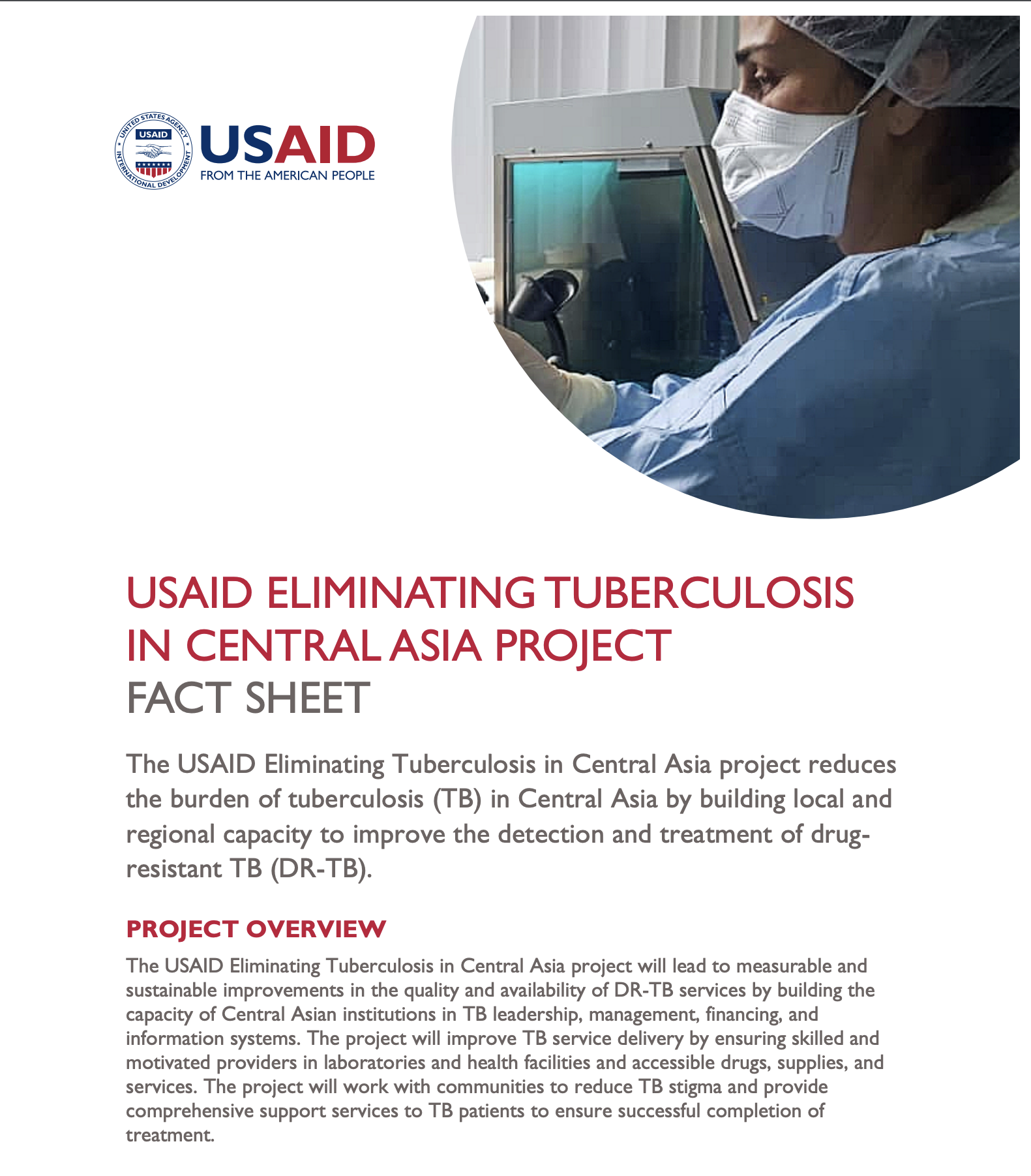Speeches Shim
USAID Eliminating Tuberculosis in Central Asia ![]() (pdf - 682k)
(pdf - 682k)
The USAID Eliminating Tuberculosis in Central Asia project reduces the burden of tuberculosis (TB) in Central Asia by building local and regional capacity to improve the detection and treatment of drug-resistant TB (DR-TB).
Project Overview
The USAID Eliminating Tuberculosis in Central Asia project will lead to measurable and sustainable improvements in the quality and availability of DR-TB services by building the capacity of Central Asian institutions in TB leadership, management, financing, and information systems. The project will improve TB service delivery by ensuring skilled and motivated providers in laboratories and health facilities and accessible drugs, supplies, and services. The project will work with communities to reduce TB stigma and provide comprehensive support services to TB patients to ensure successful completion of treatment.
Objectives
- Increase detection of TB and DR-TB;
- Increase treatment success for TB and all types of DR-TB;
- Improve enabling environment and financial sustainability of TB and DR-TB programs.
Challenges and Solutions
The high proportion of multidrug resistant-TB (MDR-TB) among patients across Central Asia suggests continued challenges in the detection and treatment of both TB and DR-TB. Countries in the region have made significant progress in strategic planning and aligning clinical practice guidelines with international recommendations but improving TB outcomes cannot be achieved at the service level alone. The project will work across three domains – systems, services, and communities – to support a transition toward sustainable, high-quality, patient-centered TB services:
-
Systems: Supporting country-driven changes to the structure, financing and management of TB services to enable the right institutions, including civil society to deliver and sustain TB care.
-
Services: Strengthening the delivery of TB care and treatment to ensure responsiveness to and support for patients from enhanced case finding to treatment completion and beyond.
-
Communities: De-stigmatizing TB, increasing understanding of diagnosis and treatment, and ensuring patient support structures are in place.
Expected Results
To reach its goal of a reduced TB burden in Central Asia, the project expects to achieve the following results:
- Increased percentage and number of DR-TB cases diagnosed;
- Increased number of DR-TB patients enrolled in new drugs and shorter treatment regimens;
- Increased percentage of TB and DR-TB patients enrolled in outpatient treatment;
- Increased percentage of individuals from vulnerable populations receiving TB testing;
- Increased number of DR-TB patients receiving community-based adherence support during treatment;
- Improved quality of diagnostic services as measured by drug susceptibility test coverage, GeneXpert coverage, and Quality Management System implementation in laboratories; and
- Improved percentage of notified TB patients who were successfully treated including DR-TB patients.
Project Duration: Regional Budget:
September 2019 –September 2024 $31,574,313
Implementing Organizations:
Abt Associates with the Institute of Microbiology and Laboratory Medicine red GmbH, SNRL Munich-Gauting, Gauting, Germany; PATH - From 1980 until 2014, PATH stood for Program for Appropriate Technology in Health, now it is know as PATH; Republican Public Organization Afif Tajikistan; Public Fund AIDS Foundation East-West in Kazakhstan, The Resource & Policy Exchange, Inc.; and Red Crescent Society of Tajikistan.
Project Area:
Tajikistan, Uzbekistan, Kazakhstan, Kyrgyz Republic, and Turkmenistan
CONTACT:
Arman Toktabayanov, Regional TB Advisor, USAID/Central Asia
e-mail: atoktabayanov@usaid.gov


Comment
Make a general inquiry or suggest an improvement.